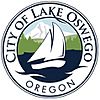Lake Oswego, Oregon facts for kids
Quick facts for kids
Lake Oswego, Oregon
|
|||
|---|---|---|---|
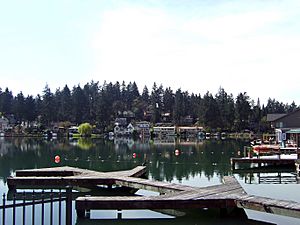
Oswego Lake in the center of the city
|
|||
|
|||
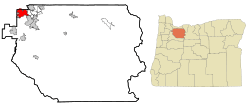
Location in Oregon
|
|||
| Country | United States | ||
| State | Oregon | ||
| Counties | Clackamas, Multnomah, Washington | ||
| Founded | 1847, incorporated 1910 | ||
| Named for | Oswego, New York | ||
| Area | |||
| • Total | 11.48 sq mi (29.75 km2) | ||
| • Land | 10.83 sq mi (28.05 km2) | ||
| • Water | 0.66 sq mi (1.70 km2) | ||
| Elevation | 249 ft (76 m) | ||
| Population
(2020)
|
|||
| • Total | 40,731 | ||
| • Density | 3,760.94/sq mi (1,452.08/km2) | ||
| Time zone | UTC−8 (Pacific) | ||
| • Summer (DST) | UTC−7 (Pacific) | ||
| ZIP codes |
97034–97035
|
||
| Area code(s) | 503 and 971 | ||
| FIPS code | 41-40550 | ||
| GNIS feature ID | 2411606 | ||
| Website | www.ci.oswego.or.us | ||
Lake Oswego is a city in Oregon, a state in the United States. It is mostly in Clackamas County, but small parts are in Multnomah County and Washington County. In 2020, about 40,731 people lived here. This made it the 11th largest city in Oregon.
Lake Oswego is about 7 miles (11 km) south of Portland. It surrounds the 405-acre (164 ha) Oswego Lake. The town started in 1847 and became a city called Oswego in 1910. In the late 1800s, it was a center for Oregon's iron industry. Today, it is a suburb of Portland.
Contents
History of Lake Oswego
Early Beginnings
The Clackamas people lived on the land that became Lake Oswego. Sadly, many of them died from diseases brought by European explorers. Before many new settlers arrived, the area had a few early farms.
The 1800s: Iron and Growth
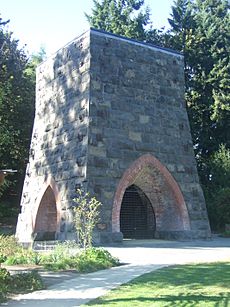
New settlers came to the area, encouraged by laws that gave them land. Albert Alonzo Durham started the town of Oswego in 1847. He named it after Oswego, New York. He built a sawmill on Sucker Creek, which is now Oswego Creek. This was the town's first business.
In 1855, the government moved the remaining Clackamas people to the Grand Ronde Indian Reservation.
Traveling by land was hard because of thick woods and muddy roads. Rivers were important for trade. A landing in today's George Rogers Park was used for moving lumber around 1850.
In 1865, iron ore was found nearby. The Oregon Iron Company was started. Within two years, they built the first large iron furnace on the West Coast. They hoped to make Oswego the "Pittsburgh of the West." The company changed owners and names several times.

The railroad came to Oswego in 1886. This train line connected Oswego directly to Portland. Before this, people used rough roads or riverboats. The railroad helped Oswego grow beyond just being an industrial town. However, it also made it easier to get cheaper iron from other parts of the country. This eventually led to the local iron industry closing down.
By 1890, the iron industry made a lot of pig iron. It employed about 300 men. This success helped Oswego develop. The town had stores, a bank, hotels, churches, and even an opera house.
The 1900s and Today
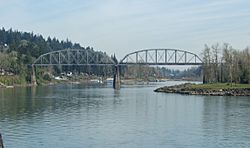
The Oregon Iron and Steel Company started selling off large parts of its land. It also built a power plant to supply electricity to Oswego citizens. As the need for iron production went down, the lake and town became popular for fun activities.
In 1910, Oswego officially became a city. The Southern Pacific Railroad improved the train line. In 1914, they made it electric, offering fast and quiet service to Portland. This service was called the Red Electric.
In 1920, the train service was very busy, with 64 trains to and from Portland daily. But passenger service ended nine years later. The line was used for freight until 1984. Today, the Willamette Shore Trolley offers tourist rides on the old line.
Paul Murphy, a land developer, helped make Oswego a great place to live. He helped create the first water system for the city. He also encouraged the building of beautiful homes in the 1930s and 1940s.
In 1960, Oswego changed its name to "Lake Oswego." This happened when it added part of Lake Grove. Historically, some nicknames for the city reflected past issues of racial exclusion. In 2020, a student from Lakeridge High School made a documentary about Lake Oswego's past regarding race.
Geography of Lake Oswego
Lake Oswego covers about 11.35 square miles (29.4 sq km). About 10.68 square miles (27.7 sq km) is land, and 0.67 square miles (1.7 sq km) is water. This area does not include some nearby land that is part of the city's service area.
Oswego Lake was originally called Waluga by the Clackamas people. It is now a lake managed by the Lake Oswego Corporation. People use the lake for boating. A dock at the east end lets boaters visit nearby shops. A main canal from the Tualatin River was dug in 1872.
Every three years, the lake's water level is lowered. This happens by opening gates on the dam. Water flows into Oswego Creek and then to the Willamette River. This allows people who own property by the lake to fix their docks and boathouses. In 2010, the lake was lowered about 24 feet (7.3 m) for a new sewer line. This was the lowest since 1962.
People of Lake Oswego
| Historical population | |||
|---|---|---|---|
| Census | Pop. | %± | |
| 1880 | 96 | — | |
| 1890 | 544 | 466.7% | |
| 1920 | 1,818 | — | |
| 1930 | 1,285 | −29.3% | |
| 1940 | 1,726 | 34.3% | |
| 1950 | 3,316 | 92.1% | |
| 1960 | 8,906 | 168.6% | |
| 1970 | 14,615 | 64.1% | |
| 1980 | 22,527 | 54.1% | |
| 1990 | 30,576 | 35.7% | |
| 2000 | 35,278 | 15.4% | |
| 2010 | 36,619 | 3.8% | |
| 2020 | 40,731 | 11.2% | |
| U.S. Decennial Census 2018 Estimate |
|||
Population in 2020
In 2020, Lake Oswego had 40,731 people. The city had about 3,761 people per square mile (1,452 per sq km). Most residents were White (80.2%). About 8.3% were Asian, and 0.8% were African American. People of Hispanic or Latino background made up 5.3% of the population.
The average age was 45.8 years. About 22.7% of residents were under 18. About 22.0% were 65 or older. The city had slightly more males (51.2%) than females (48.8%). The average household income was $127,252. About 3.9% of people lived below the poverty line.
Oswego Lake Access
Oswego Lake has been a topic of discussion. Some people believe it should be a public lake, while others say it is private. A lawsuit argued that the city was stopping people from using a public stairway in a park to swim in the lake. The City of Lake Oswego does not allow public access.
In 2019, the Oregon Supreme Court said that a 2012 city rule about lake access needed to be reviewed. The court agreed that the public has a right to enter the water from public land. They also said the city cannot stop this right. In April 2024, a judge agreed that the city had gone too far by preventing access from Millennium Park Plaza.
Schools in Lake Oswego
The Lake Oswego School District covers most of the city. It serves about 7,000 students. There are about 23 students for every teacher. The district has two high schools: Lake Oswego High School and Lakeridge High School.
There are also six elementary schools and two junior high schools. These schools serve students from grades 1 through 8. The junior high schools are Lakeridge Junior High and Lake Oswego Junior High. A small part of Lake Oswego is in the Portland Public Schools district.
Fun Places and Activities
The city has about 600 acres (2.4 sq km) of parks and open spaces. These include George Rogers Park, Millennium Plaza Park, and the Lake Oswego Golf Course.
Lake Oswego has one public library. It is part of the Library Information Network of Clackamas County. From 2002 to 2006, this library was ranked among the top 10 libraries in the U.S. for cities of similar size.
Economy: Jobs in Lake Oswego
The biggest employers in Lake Oswego include:
| # | Employer | Number of Employees |
|---|---|---|
| 1 | Lake Oswego School District | 813 |
| 2 | Mary's Woods at Marylhurst | 630 |
| 3 | Eye Health Northwest | 435 |
| 4 | Micro Systems Engineering | 406 |
| 5 | Logical Position | 380 |
| 6 | Axia Home Loan | 379 |
| 7 | City of Lake Oswego | 347 |
| 8 | Kindercare Education, LLC | 300 |
| 9 | Navex Global | 270 |
| 10 | Directors Mortgage, Inc. | 183 |
Famous People from Lake Oswego
- LaMarcus Aldridge (born 1985), former NBA basketball player
- Art Alexakis (born 1962), lead singer of the band Everclear
- Daniel Baldwin (born 1960), actor and director
- Nicolas Batum (born 1988), NBA basketball player
- J. J. Birden (born 1965), former NFL wide receiver
- Frank Brickowski (born 1959), former NBA basketball player
- Terry Dischinger (born 1940), Olympic gold medalist in basketball
- Mike Dunleavy Jr. (born 1980), former NBA basketball player
- Rudy Fernández (born 1985), NBA basketball player
- Neil Lomax (born 1959), former NFL quarterback
- Lopez Lomong (born 1983), U.S. Olympic track runner
- Stan Love (born 1949), former NBA player
- Linus Pauling (1901–1994), winner of two Nobel Prizes
- Julianne Phillips (born 1960), model and actress
- Henry Selick (born 1952), stop-motion director (The Nightmare Before Christmas)
- William Stafford (1914–1993), former U.S. Poet Laureate
- Drew Stanton (born 1984), former NFL quarterback
- Nathan Farragut Twining (1897–1982), former chairman of the U.S. Joint Chiefs of Staff
- Yeat (born 2000), rapper
Sister Cities
Lake Oswego has two sister cities:
 Yoshikawa, Saitama, Japan
Yoshikawa, Saitama, Japan Pucón, Araucanía Region, Chile
Pucón, Araucanía Region, Chile
See also
 In Spanish: Lake Oswego para niños
In Spanish: Lake Oswego para niños



